Energy Efficiency and Distributed Generation: A Case Study Applied in Public Institutions of Higher Education
Abstract
:1. Introduction
- Creation and expansion of credit lines and forms of financing projects for the installation of distributed generation systems in residential, commercial, and industrial sectors.
- Encourage the establishment of industries that manufacture components and equipment used in generation projects from renewable sources; encompassing productive, technological, and innovation development, as well as the establishment of commercial companies and service providers in distributed generation with renewable sources.
- Promote national and international investments, and facilitate the transfer and nationalization of competitive technologies associated with renewable energies.
- Encourage people to work in all renewable energy production areas.
- Replacement of inefficient equipment with more energy-efficient equipment;
- Change in the consumption habits of teachers, students, and employees of public higher education institutions;
- Implementation of mini-generation of electricity in these institutions;
- Electricity bill reduction;
- Implementation of a new form of energy management and impact analysis of this generation in the concessionaire’s network through research, development, and innovation actions;
- Technical and academic training and improvement of laboratory infrastructure.
- Optimizing energy consumption by retrofitting the lighting system;
- Installation of a photovoltaic (PV) generation system;
- Monitoring the energy flow;
- Providing training.
| Power Distribution Company | Beneficiary University | State | Result |
|---|---|---|---|
| ENEL Ceará | UNILAB | Ceará | Approved |
| ENEL Goiás | IFG | Goiás | |
| RGE Sul | UFSM | Rio Grande do Sul | |
| CEAL | UFAL | Alagoas | |
| CEPISA | UFPI | Piauí | |
| CPFL Pirapitinga | IFSP Boituva | São Paulo | |
| ELETROACRE | UFAC | Acre | |
| ENEL Rio | UFF | Rio de Janeiro | |
| ENEL Goiás | UFG | Goiás | |
| DME D | UNIFAL | Minas Gerais | |
| DME D | IF MG Sul | Minas Gerais | |
| CPFL Paulista | UNICAMP | São Paulo | Approved with recommendations |
| AES Eletropaulo | IFSP—São Paulo | São Paulo | |
| COPEL D | UEM | Paraná | |
| COPEL D | UFPR | Paraná | |
| COPEL D | UF Londrina | Paraná | |
| AES Eletropaulo | HU—USP | São Paulo | |
| AES Eletropaulo | POLITÉCNICA USP | São Paulo | |
| CERON | UNIR | Rondônia | |
| COPEL D | UTFPR Pato Branco | Paraná | |
| COPEL D | UTFPR Curitiba | Paraná | |
| AES Eletropaulo | UFABC | São Paulo |
2. Procedures of the Energy Efficiency Program (PROPEE)
- Typologies—establishes guidelines for projects and their characteristics.
- Energy efficiency action—establishes guidelines for projects by type of energy efficiency action involved to improve the installation and its end uses.
- Investment—resources necessary for the implementation of energy efficiency projects through energy performance contracts or without monetary refunds.
- Preferential prospecting—selection starts with a public call for projects or by the action of the distributor to prospect facilities with potential for project implementation.
- Special features—projects that, due to their relevance or non-typical characteristics, deserve special attention, both from the distributor and the energy regulatory agency. Special projects generally fall into the typologies defined in Module 4—Project Typologies and are classified as follows:
- a)
- Priority—wide-ranging projects whose purpose is to test, encourage, or define outstanding actions as a public policy to increase energy efficiency in the country;
- b)
- Great relevance—projects with relevant socio-environmental impact, which present clear and significant contributions to the transformation of the electricity market or which bring relevant benefits beyond the energy impact.
- c)
- Pilot—promising, unpublished, or innovative projects, including technological and/or methodological pioneering, that seek experience to subsequently expand their scale of execution.
- d)
- Cooperative—projects involving more than one energy distributor, seeking economies of scale, the complementarity of skills, the application of best practices, and improvements in the efficiency and quality of the projects carried out.
| Typologies | Energy Efficiency Action | Special Features | Investment | Preferential Prospecting | ||||||||||
|---|---|---|---|---|---|---|---|---|---|---|---|---|---|---|
| Installation Improvement | Recycling | Training and Qualification | Bonus for Efficient Equipment | Energy Management | Generation with Incentive Source | Solar Heating | Priority | Great Relevance | Pilot | Cooperative | Energy Performance Contract | Without Monetary Refund | Public Call for Projects | |
| Industrial | • | • | • | • | • | • | • | • | • | • | • | • | • | |
| Commerce and services | • | • | • | • | • | • | • | • | • | • | • | • | ✓ | • |
| Public power | • | • | • | • | • | • | • | • | • | • | • | ✓ | • | • |
| Public services | • | • | • | • | • | • | • | • | • | • | • | ✓ | • | • |
| Rural | • | • | • | • | • | • | • | • | • | • | • | • | ✓ | • |
| Residence | ✓ | • | • | • | ✓ | • | • | • | • | • | • | ✓ | • | • |
| Lowincome | • | • | • | • | • | • | • | • | • | • | ✓ | • | ||
| Municipal energy management | • | • | • | • | • | • | ||||||||
| Street lighting | • | • | • | • | • | • | • | • | • | ✓ | • | • | ||
| Educational | • | • | • | |||||||||||
- Module 1—Introduction presents an overview of PROPEE and the terms glossary;
- Module 2—Program Management presents the managerial aspects that permeate the actions of PEE;
- Module 3—Project Selection and Implementation presents a way to select projects for the PEE and provides guidance on implementation for the consumer or interested party;
- Module 4—Project Typology presents the PEE project types and their main characteristics;
- Module 5—Special Projects portrays projects that, due to their relevance or non-typical characteristics, need special attention, both from the distributor and the regulator;
- Module 6—Projects with Incentive Sources comprises energy efficiency projects with the addition of a stimulated source to attend the consumer unit;
- Module 7—Feasibility Calculation lays out the different factors and calculation forms that are considered to verify whether a project is economically viable and can be executed under the PEE, as well as other possible benefits that a project can obtain;
- Module 8—Measurement and Verification of Results establishes the procedures for a reliable assessment of the energy benefits obtained from the projects;
- Module 9—Project and Program Evaluation establishes the initial and final procedures for the evaluation of the PEE projects, and of the program as a whole for its improvement;
- Module 10—Control and Inspection establishes the guidelines for project costs and inspection activities to be carried out by ANEEL.
- Selection—includes prospecting, pre-diagnosis, and project selection activities through a public call for projects or directly by the distributor;
- Definition—definition of energy efficiency actions to be implemented with the respective technical–economic analysis and bases for M&V activities according to Module 8 (measurement and verification of results);
- SGPE—loading the project into ANEEL’s PEE information system;
- Initial evaluation—projects that require an initial evaluation according to Module 9 (project and program evaluation will be submitted to ANEEL’s prior evaluation);
- Execution—implementation of energy efficiency actions;
- Measurement and verification—reporting of M&V activities according to Module 8;
- Financial accounting audit—elaboration of a report on the expenses incurred in the execution of the project;
- Final report—elaboration of a report to present the results obtained after the conclusion of the project;
- Final evaluation—mandatory for all projects developed under the PEE and is carried out according to Module 9 (project and program evaluation);
- Monitoring—to assess the permanence of the energy efficiency actions implemented and changes in the market, follow-up studies will be carried out, as defined by ANEEL and according to Module 9 (assessment of projects and programs available on the regulatory agency’s portal).

2.1. Economic Viability
- Ex-ante evaluation is carried out with estimated values during the project definition phase. At this point, the costs and benefits of the project are evaluated based on field analyses, previous experiences, engineering calculations, and market price assessments.
- Ex-post evaluation is performed with values measured through a measurement and verification protocol and is based on the costs spent. Thus, the energy savings and demand reduction during peak hours are evaluated.
- Comparison between the benefits and financial resources spent by the EEPROJ;
- Comparison between the benefits and financial resources invested in the project by the PEE, consumers, and/or others.
- Considering the facility, calculate the energy savings and demand reduction as established in Module 7 of the Brazilian Tariff Regulation Procedures (PRORET);
- Considering the consumer, calculate the energy savings and demand reduction of energy bills.
- Generating power plant: the values of 𝐶𝐸𝐸 and 𝐶𝐸𝐷 are obtained according to final energy price and demand paid by the consumer, including taxes and charges;
- Energy efficiency actions in energy end use: the values of 𝐶𝐸𝐸 and 𝐶𝐸𝐷 are calculated according to the cost associated with the expansion of the electricity system (when available), or from the blue hourly tariff, or according to the energy tariff system, as established in Module 7 of the Brazilian Tariff Regulation Procedures (PRORET) [17], without the incidence of taxes or charges.
3. Results—Case Study
- Replacement of existing lighting systems with new and more efficient models;
- Disposal of replaced equipment;
- Installation of micro and mini PV energy generation systems;
- Installation of a PV energy generation tree;
- Implementation of an energy generation monitoring system;
- Making users aware of the efficient use of energy.
3.1. Retrofit Lighting System
3.2. Disposal of Replaced Equipment
3.3. Micro and Mini Power Generation Systems
3.4. User Awareness for the Efficient Use of Energy
- Energy efficiency program: What is energy efficiency? What are the PROPEE? What actions have been implemented in the IFG? What are the expected results? What are the benefits for the community and environment?
- Operation and maintenance of new systems: How does an efficient lighting system work? What are its components? How can we operate and maintain this? How does a PV generation plant work? What are its components? How can we operate and maintain this? How does the monitoring system work? How can we operate and maintain this?
3.5. Global Economic Analysis of the Project
4. Discussion
- Evaluate the effects of wind on the PV panels installed on building rooftops.
- Analyze the technical impact on the energy distribution networks due to the insertion of the distributed generation and energy efficiency actions using a simulation software integrated into the energy distributor system.
- Implement a complete sewage collection and treatment system and a pilot plant for the use of biogas at the IFG Aparecida de Goiânia campus. In addition, study the cooling of PV panels with reused water to maintain the conversion efficiency.
- Develop an experimental platform for the connection and interfacing of PV systems to the electricity grid.
- Conduct an economic feasibility analysis applying deterministic and stochastic methods for the installation of distributed generation systems, with simulation software as a product.
5. Conclusions
Author Contributions
Funding
Informed Consent Statement
Data Availability Statement
Acknowledgments
Conflicts of Interest
Nomenclature
| IFG | Federal Institute of Education, Science, and Technology of Goiás |
| DG | Distributed generation |
| EE | Energy efficiency |
| PBE | Brazilian Labeling Program |
| PROCEL | National Electric Energy Conservation Program |
| CONPET | National Program for the Rationalization of the Use of Natural Oil and Gas Derivatives |
| PEE | Energy Efficiency Program |
| ANEEL | National Electric Energy Agency |
| INMETRO | National Institute of Metrology, Quality, and Technology |
| PNE2030 | 2030 National Energy Plan |
| PNEf | National Energy Efficiency Plan |
| ProGD | Development of Distributed Electricity Generation |
| PROPEE | Procedures of the Energy Efficiency Program |
| EEPROJ | Energy efficiency projects |
| PRORET | Brazilian Tariff Regulation Procedures |
| LED | Light-emitting diode |
| PV systems | Photovoltaic systems |
| M&V | Measurement and verification |
| RCB | Cost–benefit ratio |
| Total annualized cost (USD/year) | |
| Total annualized benefit value (USD/year) | |
| Annual benefit of the generating plant (USD/year) | |
| Annual benefit of energy efficiency actions (USD/year) | |
| Annualized cost of each piece of equipment 𝑛 (USD/year) | |
| Cost of each piece of equipment (USD) | |
| 𝐶𝑇 | Total cost of the project (USD) |
| Total cost of n pieces of equipment (USD) | |
| Capital recovery factor for u years | |
| 𝑢 | Useful life of the equipment (years) |
| i | Annual interest rate |
| Annual energy saved (MWh/year) | |
| Unit cost of energy saved (MWh/year) | |
| Reduced demand during peak hours (kW) | |
| Unit cost of avoided demand (USD/kW) | |
| 𝐶1 | Unit cost of peak demand (USD/kW/month) |
| 𝐶2 | Unit cost of demand during off-peak hours (USD/kW/month) |
| 𝐶3 | Unit cost of energy during peak periods of dry periods (USD/MWh) |
| 𝐶4 | Unit cost of energy during peak periods of wet periods (USD/MWh) |
| 𝐶5 | Unit cost of energy during off-peak hours of dry periods (USD/MWh) |
| 𝐶6 | Unit cost of energy during off-peak hours of wet periods (USD/MWh) |
| 𝐿𝑃 | Constant loss of demand during off-peak hours, considering 1 kW of loss of demand during peak hours |
| 𝐿𝐸1 | Energy loss constant at the peak of dry periods considering 1 kW of loss of peak demand |
| 𝐿𝐸2 | Energy loss constant at the peak of wet periods considering 1 kW of peak demand loss |
| 𝐿𝐸3 | Energy loss constant at the peak of dry periods considering 1 kW of loss of demand in the off-peak hours |
| 𝐿𝐸4 | Energy loss constant at the peak of wet periods considering 1 kW of demand loss in off-peak hours |
| Fc | Load factor |
| Fp | Loss factor |
| qai | Number of lamps in the current system i |
| pai | Power of the lamp and ballast in the current system i (W) |
| hai | Current operating time of system i (h/year) |
| qpi | Number of lamps in the proposed system i |
| ppi | Power of the lamp and ballast in the proposed system i (W) |
| hpi | Operating time of the proposed system i (h/year) |
| FCPai | Tip coincidence factor in the current system i |
| FCPpi | Tip coincidence factor in the proposed system i |
| Number of months throughout the year of use at peak hours (≤12 months) | |
| Number of days during the month of use during peak hours (≤22 days) | |
| Number of hours of use during peak hours (≤3 h) | |
| Number of peak hours available over one year |
References
- Da Silva, E.P.; Marin Neto, A.J.; Ferreira, P.F.P.; Camargo, J.C.; Apolinário, F.R.; Pinto, C.S. Analysis of hydrogen production from combined photovoltaics, wind energy and secondary hydroelectricity supply in Brazil. Solar Energy 2005, 78, 670–677. [Google Scholar] [CrossRef]
- Energy Research Company (EPE). DEA Technical Note 07/13: Assessment of Energy Efficiency and Distributed Generation for the Next 10 Years (2013–2022). 2013. Available online: https://www.epe.gov.br/sites-pt/publicacoes-dadosabertos/publicacoes/PublicacoesArquivos/publicacao-245/topico-266/20140102_1[1].pdf (accessed on 13 October 2019).
- Silva, R.; Oliveira, R.; Tostes, M. Analysis of the Brazilian Energy Efficiency Program for Electricity Distribution Systems. Energies 2017, 10, 1391. [Google Scholar] [CrossRef] [Green Version]
- Ripple, W.J.; Wolf, C.; Newsome, T.M.; Galetti, M.; Alamgir, M.; Crist, E.; Mahmoud, M.I.; Laurance, W.F. World scientists’ warning to humanity: A second notice. BioScience 2017, 67, 1026–1028. [Google Scholar] [CrossRef]
- Energy Research Company (EPE). DEA Technical Note 025/17: Energy Efficiency Studies—Monitoring the Progress of Energy Efficiency in Brazil. Ministério de Minas e Energia: Brasilia, Brazil, 2017. Available online: https://www.epe.gov.br/sites-pt/publicacoes-dados-abertos/publicacoes/PublicacoesArquivos/publicacao-251/topico-311/DEA%20025-17%20-%20%20Indicadores%20de%20Efici%C3%AAncia%20Energ%C3%A9tica.pdf (accessed on 20 September 2020).
- National Electric Energy Agency (ANEEL). Normative Resolution 482. 2012. Available online: http://www2.aneel.gov.br/cedoc/ren2012482.pdf (accessed on 15 September 2019).
- Ates, Y.; Boynuegri, A.; Uzunoglu, M.; Nadar, A.; Yumurtacı, R.; Erdinc, O.; Paterakis, N.; Catalão, J. Adaptive Protection Scheme for a distribution system considering grid-connected and islanded modes of operation. Energies 2016, 9, 378. [Google Scholar] [CrossRef]
- Electrical Energy Research Center—CEPEL. Guide to Energy Efficiency in Public Buildings. 2014. Available online: https://www.gov.br/mme/pt-br/assuntos/noticias/mme-lanca-guia-para-eficiencia-energetica-nas-edificacoes-publicas (accessed on 3 February 2022).
- Law 10295 of 17 October 2001. Presidency of the Republic. Brazil. 2001; pp. 1–2. Available online: http://www.planalto.gov.br/ccivil_03/leis/leis_2001/l10295.htm (accessed on 20 September 2020).
- Law 9991 of 24 July 2000. Presidency of the Republic. Brazil. 2000; pp. 1–7. Available online: http://www.planalto.gov.br/ccivil_03/leis/l9991.htm (accessed on 18 October 2019).
- Ministry of Mines and Energy (MME)/Energy Research Company (EPE). 2030 National Energy Plan: Projections. 2007. Available online: http://www.epe.gov.br/PNE/20080512_2.pdf (accessed on 12 September 2019).
- Ministry of Mines and Energy (MME). National Plan for Energy Efficiency: Premises and Basic Directives. 2011. Available online: http://antigo.mme.gov.br/web/guest/secretarias/planejamento-e-desenvolvimento-energetico/publicacoes/plano-nacional-de-eficiencia-energetica(accessed on 15 January 2021).
- National Electric Energy Agency (ANEEL). Normative Resolution 687. 2015. Available online: http://www2.aneel.gov.br/cedoc/ren2015687.pdf (accessed on 20 September 2020).
- Ministry of Mines and Energy (MME). Ordinance 538. Distributed Electricity Generation Development Program (ProGD). 2015. Available online: http://www.abgd.com.br/portal/doc/201904150125-01-49a661_7be2db8614614903ab1c552ec2025e60.pdf. (accessed on 10 September 2020).
- National Electric Energy Agency (ANEEL). Public Call for Priority Projects for EE and Strategic R&D No. 01/2016—Energy Efficiency and Minigeneration in Public Institutions of Higher Education. 2016. Available online: https://www.aneel.gov.br/documents/656831/14930433/Prioritário+e+Estratégico+%28Edital+final%29/7817f2ab-0f65-42b8-b8d4-e91a2b61239f (accessed on 10 September 2020).
- National Electric Energy Agency (ANEEL). Procedures of the Energy Efficiency Program (PROPEE). 2018. Available online: https://www.aneel.gov.br/pt/programa-eficiencia-energetica/ (accessed on 14 October 2019).
- National Electric Energy Agency (ANEEL). Tariff Regulation Procedures (PRORET). 2011. Available online: https://www.aneel.gov.br/procedimentos-de-regulacao-tarifaria-proret (accessed on 5 September 2019).
- National Electric Energy Agency (ANEEL). Normative Resolution 920. 2021. Available online: https://www.in.gov.br/en/web/dou/-/resolucao-normativa-aneel-n-920-de-23-de-fevereiro-de-2021-*-306209537. (accessed on 12 January 2022).
- De Almeida, A.; Santos, B.; Paolo, B.; Quicheron, M. Solid state lighting review—Potential and challenges in Europe. Renew. Sustain. Energy Rev. 2014, 34, 30–48. [Google Scholar] [CrossRef]
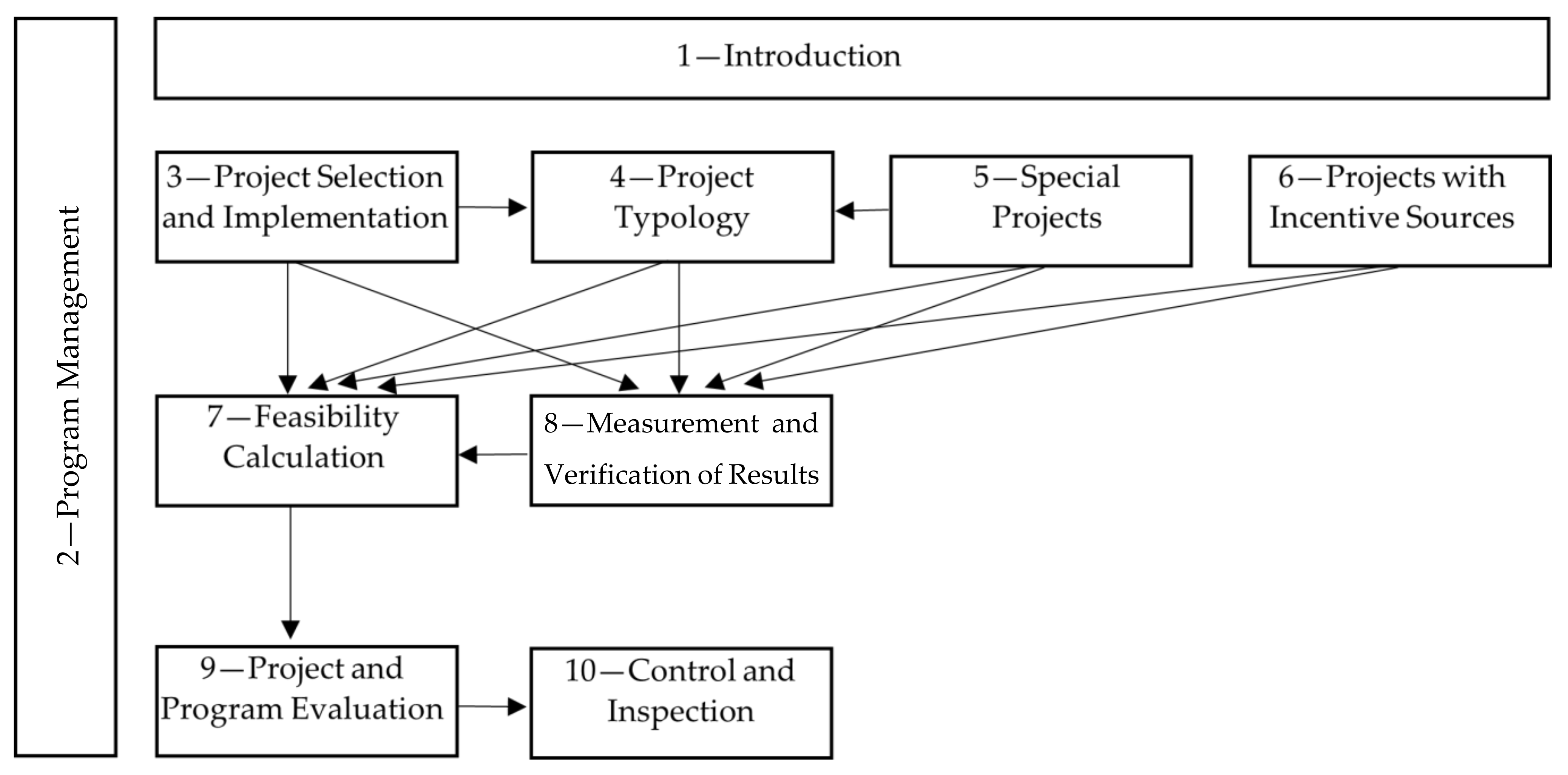
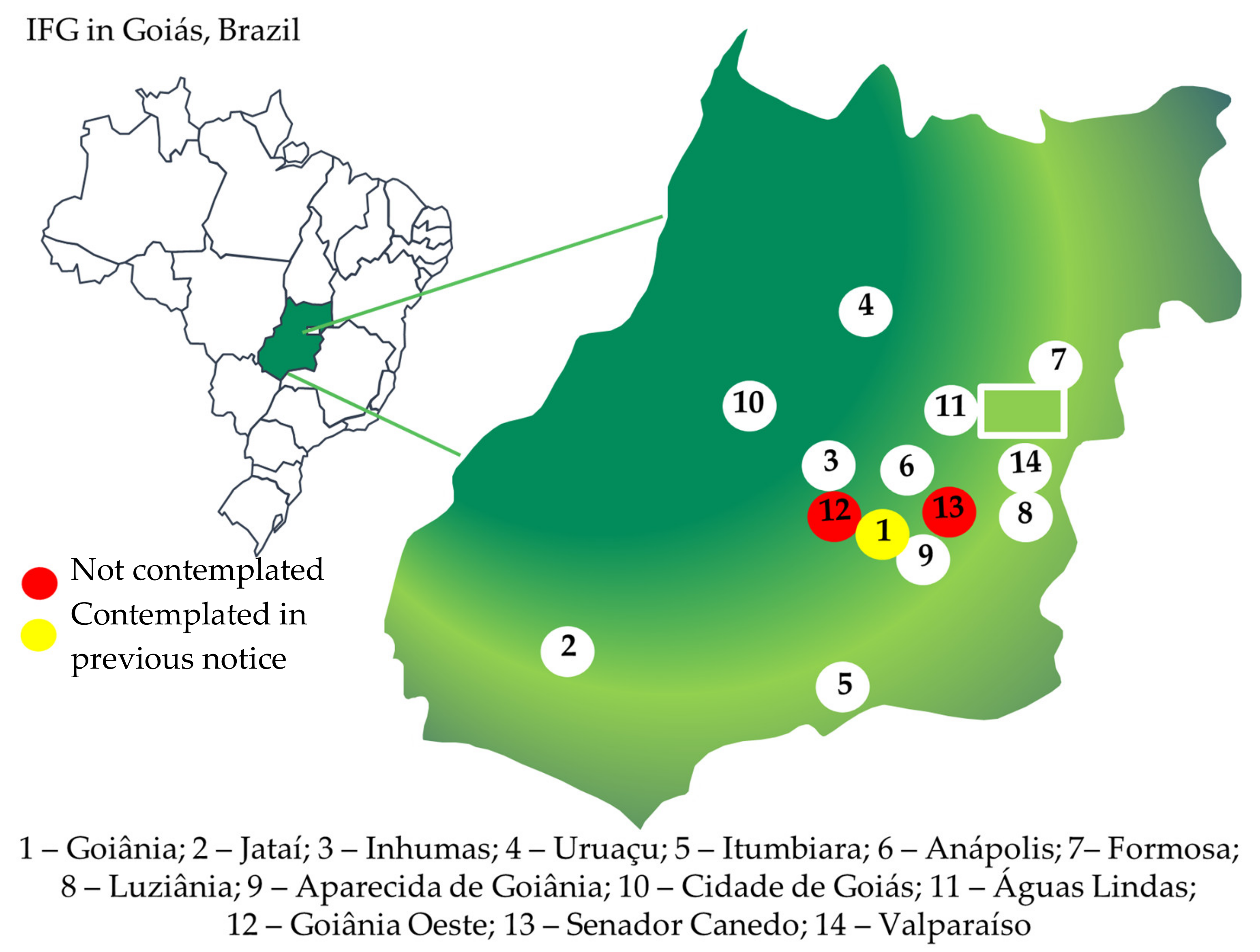
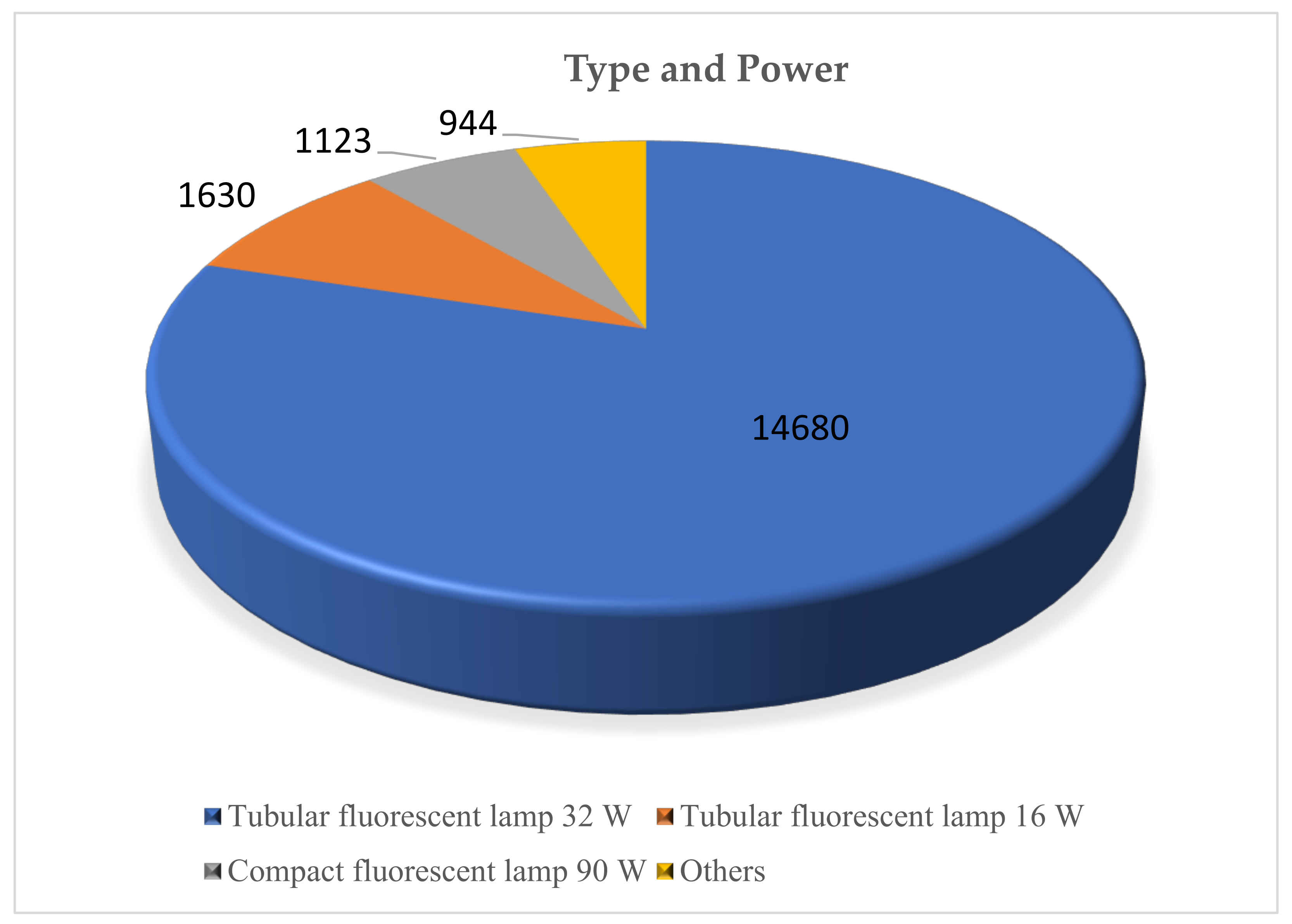


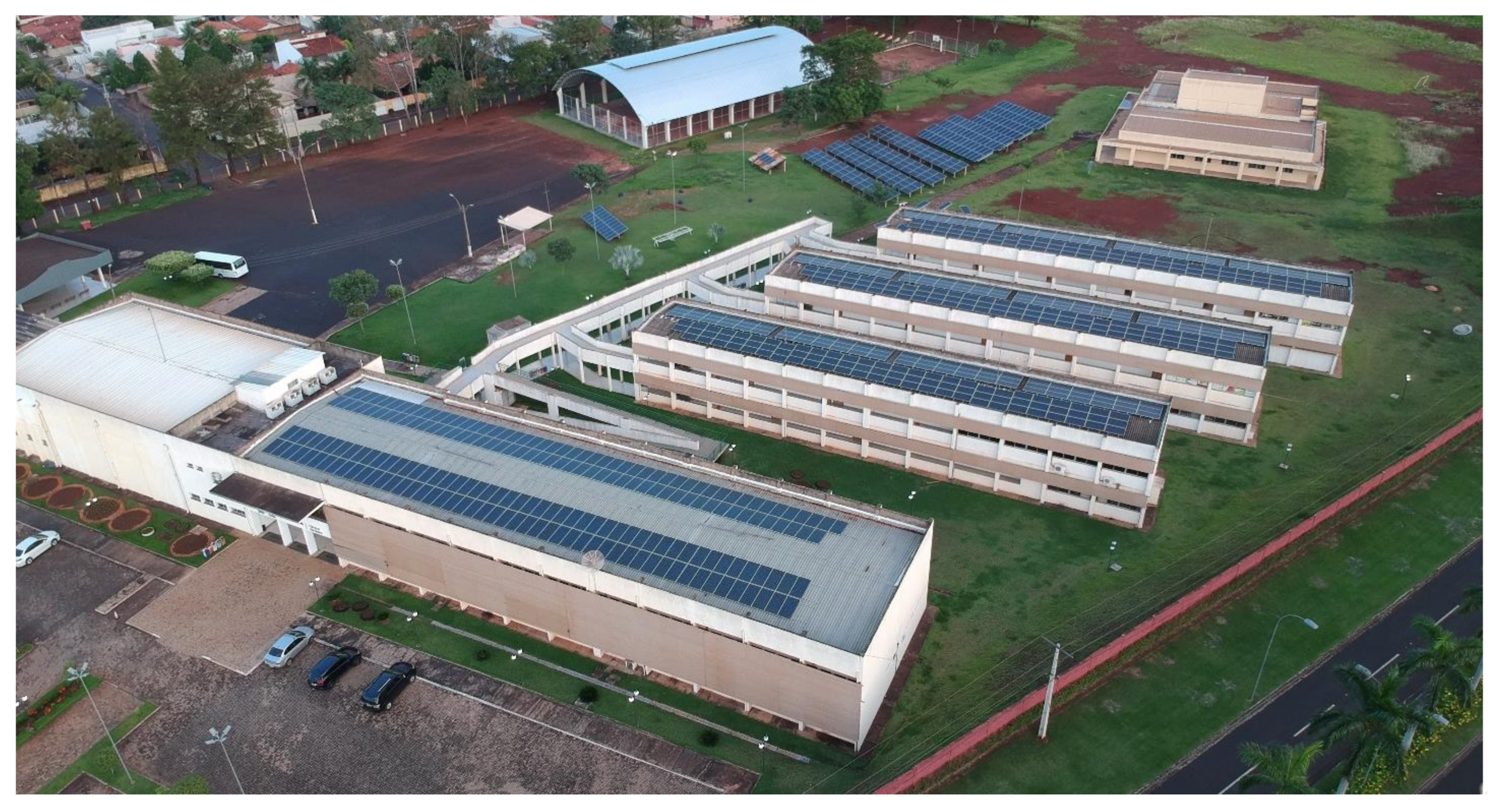
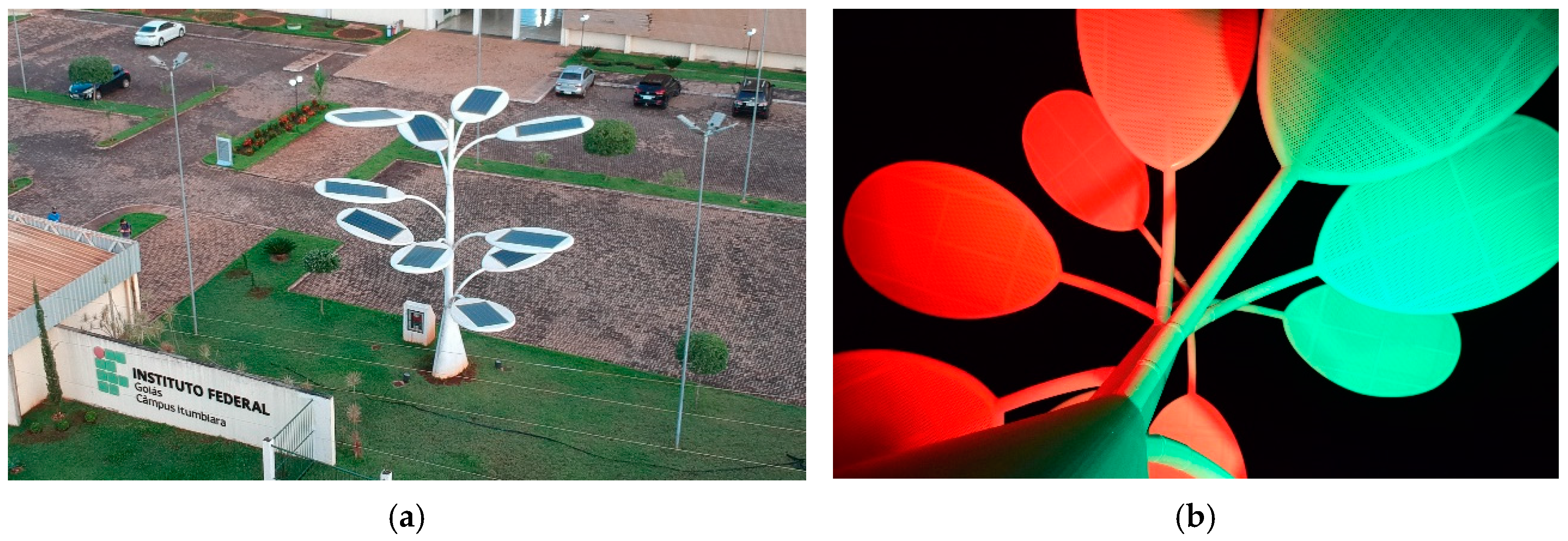
| Factor of Charge | LP | LE1 | LE2 | LE3 | LE4 |
|---|---|---|---|---|---|
| 0.3 | 0.25 | 0.2732 | 0.1912 | 0.3517 | 0.2483 |
| 0.35 | 0.2809 | 0.2849 | 0.1995 | 0.5203 | 0.3674 |
| 0.4 | 0.3136 | 0.2973 | 0.2081 | 0.7101 | 0.5015 |
| 0.45 | 0.3481 | 0.3101 | 0.2171 | 0.9213 | 0.6506 |
| 0.5 | 0.3844 | 0.3236 | 0.2265 | 1.1538 | 0.8147 |
| 0.55 | 0.4225 | 0.3375 | 0.2363 | 1.4075 | 0.9939 |
| 0.6 | 0.4624 | 0.352 | 0.2464 | 1.6825 | 1.1881 |
| 0.65 | 0.5041 | 0.3695 | 0.2587 | 1.9763 | 1.3956 |
| 0.7 | 0.5476 | 0.3852 | 0.2696 | 2.2938 | 1.6198 |
| IFG—Campus | Contracted Demand (kW) | Total Consumption (MWh/year) | Annual Average Energy Expenditure (USD) | |
|---|---|---|---|---|
| 1 | Jataí | 60 | 221.8 | 13,679.49 |
| 2 | Inhumas | 90 | 195.0 | 23,166.88 |
| 3 | Uruaçu | 180 | 309.2 | 48,540.12 |
| 4 | Itumbiara | 250 | 275.0 | 44,127.38 |
| 5 | Anápolis | 114 | 157.0 | 34,383.74 |
| 6 | Formosa | 75 | 136.0 | 9928.66 |
| 7 | Luziânia | 110 | 166.8 | 33,095.54 |
| 8 | Aparecida | 350 | 369.4 | 31,771.71 |
| 9 | Goiás | 30 | 40.0 | 10,664.12 |
| 10 | Águas lindas | 80 | 62.3 | 11,914.39 |
| 11 | Valparaíso | 30 | 14.1 | 15,444.58 |
| TOTAL | 1369 | 1946 | 267,264.84 | |
| Description | Power (W) | Quantities | Demand (kW) | Operation (hours/year) | Consumption (kWh/year) |
|---|---|---|---|---|---|
| Dichroic lamp | 50 | 187 | 9.35 | 2640 | 24,684 |
| Mixed lamp | 250 | 6 | 1.50 | 2640 | 3960 |
| Mixed lamp | 400 | 24 | 9.60 | 2640 | 25,344 |
| Halogen lamp + electronic ballast | 122.5 | 158 | 19.36 | 2640 | 51,097.2 |
| Sodium vapor lamp + electronic ballast | 274 | 197 | 53.98 | 2640 | 142,501.9 |
| Sodium vapor lamp + electronic ballast | 432 | 82 | 35.42 | 2640 | 93,519.4 |
| Compact fluorescent lamp | 15 | 1123 | 16.85 | 2640 | 44,470.8 |
| Compact fluorescent lamp | 45 | 49 | 2.21 | 2640 | 5821.2 |
| Compact fluorescent lamp | 90 | 92 | 8.28 | 2640 | 21,859.2 |
| Tubular fluorescent lamp + electronic ballast | 17.5 | 1630 | 28.53 | 2640 | 75,306 |
| Tubular fluorescent lamp + electronic ballast | 33.5 | 14,680 | 491.78 | 2640 | 1,298,299.2 |
| Compact fluorescent lamp reflector | 54 | 1 | 0.05 | 2640 | 142.6 |
| Mixed lamp reflector | 250 | 93 | 23.25 | 2640 | 61,380 |
| Metallic vapor lamp reflector + electronic ballast | 432 | 55 | 23.76 | 2640 | 62,726.4 |
| Total | - | 18,377 | 723.91 | - | 1,911,111.84 |
| Existing Lighting System | Proposed Lighting System | Quantities |
|---|---|---|
| Dichroic lamp 50 W | LED dichroic lamp 6 W | 187 |
| Mixed lamp 250 W | LED high bay lamp 80 W | 6 |
| Mixed lamp 400 W | LED high bay lamp 150 W | 24 |
| Halogen lamp 110 W | LED halogen lamp 40 W | 158 |
| Sodium vapor lamp 250 W | LED street light 120 W | 197 |
| Sodium vapor lamp 400 W | LED street light 210 W | 82 |
| Compact fluorescent lamp 15 W | LED bulb lamp 8 W | 1123 |
| Compact fluorescent lamp 45 W | LED bulb lamp 16 W | 49 |
| Compact fluorescent lamp 90 W | LED bulb lamp 30 W | 92 |
| Tubular fluorescent lamp 16 W | LED tubular lamp 10 W | 1630 |
| Tubular fluorescent lamp 32 W | LED tubular lamp 20 W | 14,680 |
| Compact fluorescent lamp reflector 54 W | LED reflector 30 W | 1 |
| Mixed lamp reflector 250 W | LED reflector 100 W | 93 |
| Metallic vapor lamp reflector 400 W | LED reflector 200 W | 55 |
| Total | Total | 18,377 |
| System | (MWh/year) | (kW) | RCB | ||||
|---|---|---|---|---|---|---|---|
| Lighting | 867.94 | 309.63 | 79.14 | 52.47 | 34,895.03 | 70,044.65 | 0.50 |
| Description | Type |
|---|---|
| Manufacturer | GCL SOLAR |
| Technology | Polycrystalline |
| Maximum power | 325 Wp |
| Area | 1.94 m2 |
| Efficiency | 16.70% |
| IFG—Campus | Area (m2) | Number of FV Modules | Installed Power (kWp) | Estimated Electricity Generation (MWh/year) | |
|---|---|---|---|---|---|
| 1 | Jataí | 5058 | 277 | 90 | 161.33 |
| 2 | Inhumas | 1910 | 277 | 90 | 156.24 |
| 3 | Uruaçu | 1894 | 277 | 90 | 160.83 |
| 4 | Itumbiara | 4152 | 554 | 180 | 307.64 |
| 5 | Anápolis | 4855 | 308 | 100 | 188.88 |
| 6 | Formosa | 4998 | 231 | 75 | 133.84 |
| 7 | Luziânia | 5740 | 338 | 110 | 199.27 |
| 8 | Goiás | 6755 | 92 | 30 | 51.00 |
| 9 | Águas Lindas | 6000 | 246 | 80 | 143.3 |
| 10 | Aparecida | 4420 | 338 | 110 | 156.24 |
| 11 | Valparaíso | 2097 | 138 | 45 | 78.33 |
| TOTAL | 47,879 | 3076 | 1000 | 1736.9 | |
| System | (MWh/year) | (kW) | (USD/kW) | (USD/MWh) | (USD) | (USD) | RCB |
|---|---|---|---|---|---|---|---|
| Photovoltaic | 1736.90 | - | - | 75.75 | 101,288.97 | 131,564.26 | 0.77 |
| System | (MWh/year) | RCB | |||
|---|---|---|---|---|---|
| Lighting | 867.94 | 309.63 | 34,895.03 | 70,044.65 | 0.50 |
| Photovoltaic | 1736.90 | 0.00 | 101,288.97 | 131,564.26 | 0.77 |
| Total | 2604.84 | 309.63 | 136,184.00 | 201,608.91 | 0.68 |
| Global RCB | 0.68 | ||||
| Lighting | Photovoltaic Generation | ||
|---|---|---|---|
| Quantity of Equipment | 18,377 | Quantity of Equipment | 3076 |
| Energy Saving (MWh/year) | 867.94 | Energy Saving (MWh/year) | 1736.90 |
| Demand Reduction at the Point (kW) | 309.63 | Demand Reduction at the Point (kW) | 0 |
| Total Investment (USD) | 425,252.34 | Total Investment (USD) | 923,516.15 |
| Investment in Equipment (USD) | 196,867.51 | Investment Equipment (USD) | 761,293.94 |
| Own Labor—Concessionary (USD) | 5545.86 | Own Labor—Concessionary (USD) | 21,446.06 |
| Third-party labor (USD) | 165,564.65 | Third-party labor (USD) | 250,698.68 |
| Transportation—Concessionary (USD) | 310.17 | Transportation—Concessionary (USD) | 1199.43 |
| Elaboration of the Project (diagnosis) (USD) | 10,955.45 | Elaboration of the Project (diagnosis) (USD) | 42,365.13 |
| Marketing—Estate Agent (USD) | 755.55 | Marketing—Estate Agent (USD) | 2921.73 |
| Training (USD) | 755.51 | Training (USD) | 2921.59 |
| Discard (USD) | 5581.34 | Discard (USD) | - |
| M&V (USD) | 22,935.21 | M&V (USD) | 15,058.47 |
| (USD/MWh) | 52.47 | (USD/MWh) | 75.75 |
| (USD/MWh) | 79.14 | (USD/MWh) | - |
| RCB | 0.50 | RCB | 0.77 |
Publisher’s Note: MDPI stays neutral with regard to jurisdictional claims in published maps and institutional affiliations. |
© 2022 by the authors. Licensee MDPI, Basel, Switzerland. This article is an open access article distributed under the terms and conditions of the Creative Commons Attribution (CC BY) license (https://creativecommons.org/licenses/by/4.0/).
Share and Cite
Faria, A.; Alvarenga, B.; Lemos, G.; Viajante, G.; Domingos, J.L.; Marra, E. Energy Efficiency and Distributed Generation: A Case Study Applied in Public Institutions of Higher Education. Energies 2022, 15, 1217. https://doi.org/10.3390/en15031217
Faria A, Alvarenga B, Lemos G, Viajante G, Domingos JL, Marra E. Energy Efficiency and Distributed Generation: A Case Study Applied in Public Institutions of Higher Education. Energies. 2022; 15(3):1217. https://doi.org/10.3390/en15031217
Chicago/Turabian StyleFaria, Adriano, Bernardo Alvarenga, Gerley Lemos, Ghunter Viajante, José Luis Domingos, and Enes Marra. 2022. "Energy Efficiency and Distributed Generation: A Case Study Applied in Public Institutions of Higher Education" Energies 15, no. 3: 1217. https://doi.org/10.3390/en15031217







